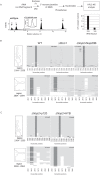Eukaryotic rRNA Modification by Yeast 5-Methylcytosine-Methyltransferases and Human Proliferation-Associated Antigen p120
- PMID: 26196125
- PMCID: PMC4510066
- DOI: 10.1371/journal.pone.0133321
Eukaryotic rRNA Modification by Yeast 5-Methylcytosine-Methyltransferases and Human Proliferation-Associated Antigen p120
Abstract
Modified nucleotide 5-methylcytosine (m5C) is frequently present in various eukaryotic RNAs, including tRNAs, rRNAs and in other non-coding RNAs, as well as in mRNAs. RNA:m5C-methyltranferases (MTases) Nop2 from S. cerevisiae and human proliferation-associated nucleolar antigen p120 are both members of a protein family called Nop2/NSUN/NOL1. Protein p120 is well-known as a tumor marker which is over-expressed in various cancer tissues. Using a combination of RNA bisulfite sequencing and HPLC-MS/MS analysis, we demonstrated here that p120 displays an RNA:m5C- MTase activity, which restores m5C formation at position 2870 in domain V of 25S rRNA in a nop2Δ yeast strain. We also confirm that yeast proteins Nop2p and Rcm1p catalyze the formation of m5C in domains V and IV, respectively. In addition, we do not find any evidence of m5C residues in yeast 18S rRNA. We also performed functional complementation of Nop2-deficient yeasts by human p120 and studied the importance of different sequence and structural domains of Nop2 and p120 for yeast growth and m5C-MTase activity. Chimeric protein formed by Nop2 and p120 fragments revealed the importance of Nop2 N-terminal domain for correct protein localization and its cellular function. We also validated that the presence of Nop2, rather than the m5C modification in rRNA itself, is required for pre-rRNA processing. Our results corroborate that Nop2 belongs to the large family of pre-ribosomal proteins and possesses two related functions in pre-rRNA processing: as an essential factor for cleavages and m5C:RNA:modification. These results support the notion of quality control during ribosome synthesis by such modification enzymes.
Conflict of interest statement
Figures




References
-
- Salozhin SV, Prokhorchuk EB, Georgiev GP. Methylation of DNA—one of the major epigenetic markers. Biochemistry (Mosc) 2005;70(5):525–32. - PubMed
-
- Smith JE, Cooperman BS, Mitchell P. Methylation sites in Escherichia coli ribosomal RNA: localization and identification of four new sites of methylation in 23S rRNA. Biochemistry 1992;31(44):10825–34. - PubMed
-
- Brand RC, Klootwijk J, Van Steenbergen TJ, De Kok AJ, Planta RJ. Secondary methylation of yeast ribosomal precursor RNA. Eur J Biochem 1977;75(1):311–8. - PubMed
Publication types
MeSH terms
Substances
LinkOut - more resources
Full Text Sources
Other Literature Sources
Molecular Biology Databases

